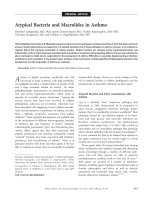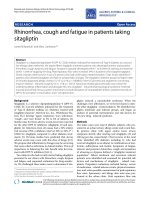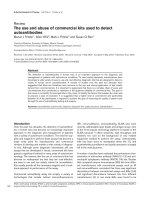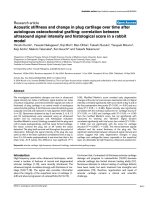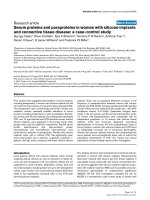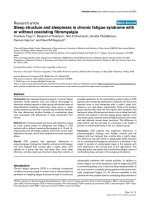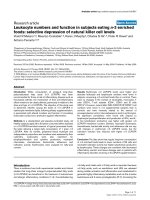Báo cáo y học: "Resource use and outcome in critically ill patients with hematological malignancy: a retrospective cohort study" pot
Bạn đang xem bản rút gọn của tài liệu. Xem và tải ngay bản đầy đủ của tài liệu tại đây (158.56 KB, 9 trang )
Open Access
Available online />Page 1 of 9
(page number not for citation purposes)
Vol 12 No 3
Research
Resource use and outcome in critically ill patients with
hematological malignancy: a retrospective cohort study
Tobias M Merz
1
, Pascale Schär
2
, Michael Bühlmann
3
, Jukka Takala
4
and Hans U Rothen
4
1
Department of Intensive Care Medicine, Royal North Shore Hospital of Sydney, University of Sydney, St Leonards, 2065 NSW, Australia
2
Department of Internal Medicine, Inselspital, Bern University Hospital and University of Bern, 3010 Bern, Switzerland
3
Department of Medical Oncology, Inselspital, Bern University Hospital and University of Bern, 3010 Bern, Switzerland
4
Department of Intensive Care Medicine, Inselspital, Bern University Hospital and University of Bern, 3010 Bern, Switzerland
Corresponding author: Tobias M Merz,
Received: 27 Dec 2007 Revisions requested: 2 Feb 2008 Revisions received: 8 Apr 2008 Accepted: 6 Jun 2008 Published: 6 Jun 2008
Critical Care 2008, 12:R75 (doi:10.1186/cc6921)
This article is online at: />© 2008 Merz et al.; licensee BioMed Central Ltd.
This is an open access article distributed under the terms of the Creative Commons Attribution License ( />),
which permits unrestricted use, distribution, and reproduction in any medium, provided the original work is properly cited.
Abstract
Introduction The paucity of data on resource use in critically ill
patients with hematological malignancy and on these patients'
perceived poor outcome can lead to uncertainty over the extent
to which intensive care treatment is appropriate. The aim of the
present study was to assess the amount of intensive care
resources needed for, and the effect of treatment of, hemato-
oncological patients in the intensive care unit (ICU) in
comparison with a nononcological patient population with a
similar degree of organ dysfunction.
Methods A retrospective cohort study of 101 ICU admissions
of 84 consecutive hemato-oncological patients and 3,808 ICU
admissions of 3,478 nononcological patients over a period of 4
years was performed.
Results As assessed by Therapeutic Intervention Scoring
System points, resource use was higher in hemato-oncological
patients than in nononcological patients (median (interquartile
range), 214 (102 to 642) versus 95 (54 to 224), P < 0.0001).
Severity of disease at ICU admission was a less important
predictor of ICU resource use than necessity for specific
treatment modalities. Hemato-oncological patients and
nononcological patients with similar admission Simplified Acute
Physiology Score scores had the same ICU mortality. In hemato-
oncological patients, improvement of organ function within the
first 48 hours of the ICU stay was the best predictor of 28-day
survival.
Conclusion The presence of a hemato-oncological disease per
se is associated with higher ICU resource use, but not with
increased mortality. If withdrawal of treatment is considered, this
decision should not be based on admission parameters but
rather on the evolutional changes in organ dysfunctions.
Introduction
Patients with hematological malignancy who are admitted to
the intensive care unit (ICU) due to complications of the under-
lying malignant disease often have a prolonged stay in the ICU
[1] and are believed to have a less favorable prognosis [2]
than nononcological patients. In general adult ICU popula-
tions, prolonged stay has been reported to be associated with
a disproportionate use of resources [3]. Information on
resource use of hemato-oncological patients requiring inten-
sive care is relatively scarce [4,5], however, and comparisons
with other nononcological intensive care patient groups do not
exist. The paucity of data on resource use in hemato-oncolog-
ical patients and the perceived poor outcome can lead to
uncertainty over the extent to which intensive care treatment is
appropriate in this patient group [6-8]. Decisions to admit can-
cer patients to the ICU are exceptionally complex, as the
chances of potentially curative cancer therapy or long-term
palliation must be weighed against the associated risk of very
high morbidity or mortality and thus possible futile use of more
and more limited resources.
Reported ICU mortality rates of critically ill hemato-oncological
patients vary widely, from 10% up to 50% depending on the
studied population [9-11]. The prognostic value of various clin-
ical indicators – such as age, primary disease, chronic health
status, cardiovascular failure, renal insufficiency, leucopenia or
95% CI = 95% confidence interval; ICU = intensive care unit; SAPS II = Simplified Acute Physiology Score II; SOFA = Sequential Organ Failure
Assessment; TISS-28 = Therapeutic Intervention Scoring System.
Critical Care Vol 12 No 3 Merz et al.
Page 2 of 9
(page number not for citation purposes)
recent bacteremia [12] – is in dispute. Likewise, the value of
various scoring systems applied at the time of ICU admission
to predict outcome is controversial [13,14]. Extending any pre-
diction to individual patients remains a clinical decision for
which specific outcome indicators provide little help.
Furthermore, treatments and outcomes of various malignan-
cies have changed, suggesting that re-evaluation of indica-
tions and outcomes of intensive care for this patient group is
necessary. Although a multicenter approach is considered
necessary to generate the number of patients needed to eval-
uate any prognostic indicator, a more detailed evaluation of
resource utilization may benefit from a single-center analysis,
which avoids the effect of variability between different ICUs
[15].
Accordingly, the primary aim of the present single-center study
was to assess the amount of resources used per patient for
hemato-oncological and nononcological emergency admis-
sions to the ICU. A secondary aim was to explore the survival
of hemato-oncological patients depending on their pre-exist-
ing comorbidities and on the severity of acute illness on admis-
sion and during the course of the ICU stay, and in comparison
with a nononcological patient population with a similar degree
of organ dysfunction.
Materials and methods
Setting
The Bern University Hospital, Switzerland, is a 960-bed tertiary
care referral hospital. The Department of Intensive Care Medi-
cine is the sole provider of intensive care for adult patients in the
hospital. The department comprises 30 beds, and is operated
as a closed unit. Care is offered for all types of surgical, trauma
and medical patients, except major burn injuries. Admission of
hemato-oncological patients to the ICU takes place after con-
sultation with the treating oncologist and a senior intensive care
physician. Criteria for admission are largely identical for hemato-
oncological patients and for nononcological patients [16]. We
tend to abstain from admission of a hemato-oncological patient
in the case of progressed malignancy and short expected sur-
vival time (<3 months). The Department of Medical Oncology
includes an inpatient section with 50 beds and an outpatient
section handling approximately 13,000 consultations per year.
Patients and data collection
The collective of hemato-oncological patients included in the
present retrospective cohort study consisted of all patients with
a primary diagnosis of leukemia, lymphoma or myeloma admit-
ted to the ICU from July 2001 to July 2005 due to a severe dete-
rioration in their general condition. Patients referred to the ICU
solely for rhythm monitoring during a chemotherapeutical inter-
vention were excluded. The collective of nononcological
patients evaluated for comparison consisted of all medical
patients admitted as emergencies to the ICU during the same
period of time. Patients admitted after elective or emergency
surgery were excluded from the analysis. For comparison of
hemato-oncological and nononcological patient survival and
resource use (see below), readmissions occurring within 48
hours of discharge from the ICU were considered with the initial
admission, whereas readmissions beyond 48 hours were ana-
lyzed as new cases [17].
The ICU stay parameters for all patients were collected from the
ICU database. These parameters included age, sex, date of
admission to the hospital, date of each ICU admission through-
out the hospital stay, reason for ICU admission, date of and sta-
tus at ICU discharge, Simplified Acute Physiology Score (SAPS
II) [18] calculated for the first 24 hours of the ICU stay, and the
amount of Therapeutic Intervention Scoring System (TISS-28)
points [19] accumulated throughout the ICU stay. As treatment
intensity often changes markedly, even within 1 day, we calcu-
lated the TISS-28 score once per nursing shift (that is, every 8
hours) [3,20]. Patient-related direct costs were calculated
based on the hospital cost accounting, and amounted to 38
Swiss Francs per TISS-28 point.
The Sequential Organ Failure Assessment (SOFA) score [21]
for each day of the ICU stay was collected from information in
the medical records and was available only for hemato-oncolog-
ical patients, as it is not part of the ICU database. To assess the
change during the first 48 hours of the ICU stay, the difference
between the patients' SOFA score at ICU admission and after
the first 24 and 48 hours of the ICU stay was calculated. Stabi-
lization of the patients' condition was defined as an unchanged
or decreased SOFA score, and deterioration was defined as an
increased SOFA score. The use of renal replacement therapy
(intermittent hemodialysis or continuous hemodiafiltration) and
mechanical ventilation were also recorded.
Additional data on hemato-oncological patients, collected from
their medical records, included primary oncological diagnosis,
presence of neutropenia (defined as minimal absolute neu-
trophil count <500/μl) and the type of anticancer treatment. The
type of hematological malignancy was categorized into high-
grade malignancy (acute myelogenous leukemia, acute lym-
phoblastic leukemia and high-grade non-Hodgkin's lymphoma)
and low-grade malignancy (all other types of hematologic malig-
nancies) [12].
To evaluate underlying comorbidities we used the Adult Comor-
bidity Evaluation-27 system [22], which contains 12 comorbid
ailments (cardiovascular, respiratory, gastrointestinal, renal,
endocrine and neurological systems, psychiatric, rheumatologi-
cal and immunological disorders, malignancy, substance abuse,
and body weight). Each of these comorbidities was classified by
Grade 0 to 3 (0 = no comorbidity, 1 = mild, 2 = moderate, 3 =
severe comorbidity). To evaluate the overall comorbidity index
we ranked the highest single ailment, except when two or more
grade 2 ailments occurred in different organ systems. In this
case we designated the overall comorbidity score as grade 3.
Available online />Page 3 of 9
(page number not for citation purposes)
Survival at 28 days and 1 year after ICU admission was
obtained from the patient files of the oncological outpatient sec-
tion.
Statistical analysis
Data are presented as the mean ± standard deviation or the
median (interquartile range) as appropriate. Outcome groups
on the basis of hospital survival/nonsurvival and resource use in
nononcological patients and hemato-oncological patients were
compared using an unpaired t test and the Mann–Whitney test
for continuous variables with normal and skewed distributions,
respectively. Fisher's exact test or the Pearson chi-square test
was used for categorical variables. The correlation between rea-
son for ICU admission, Adult Comorbidity Evaluation-27 score
as well as type of anticancer treatment and outcome was
assessed by applying categorical logistic regression.
To compare resource use in nononcological patients and in
hemato-oncological patients after correction for severity of
organ dysfunction at ICU admission, a stepwise multiple linear
regression model was applied including SAPS II and the pres-
ence or absence of hematological malignancy as predictors.
To compare ICU mortality in nononcological patients and in
hemato-oncological ICU patients, a stepwise multiple logistic
regression model was applied, including SAPS II and the pres-
ence or absence of hematological malignancy as predictors. To
avoid colinearity, for all regression analyses including nononco-
logical patients, SAPS II values for hemato-oncological patients
were reduced by 10 points to balance the number of SAPS II
points added in the original score for the presence of hemato-
logical malignancy. For the direct comparison of the prognostic
value of SOFA scores and SAPS II and the change of the SOFA
score in the first 24 and 48 hours, Pearson's chi-square test
was used. The same test was used to analyze the effect of use
of mechanical ventilation and renal replacement therapy with
respect to 28-day mortality. All these results are reported as
contingency coefficients [23]. Accordingly, the continuous vari-
ables SOFA score and SAPS II had to be dichotomized. This
was achieved using receiver operating characteristic curves,
plotting sensitivity versus 1 – specificity. Based on these
receiver operating characteristic curves, we defined cutoff val-
ues for SAPS II and the SOFA scores that discriminated best
between survivors and nonsurvivors at day 28.
Additionally, the independent predictive value of the change in
SOFA score and of absolute organ failure scores at ICU admis-
sion was assessed in two logistic regression models. The first
model analyzed the change in SOFA score and admission
SAPS II value; the second model included the change in the
SOFA score and the absolute admission SOFA score.
In all analyses, P < 0.05 was considered statistically significant.
Statistical analyses were performed using the software package
SPSS, version 13.0 (SPSS, Inc., Chicago, IL, USA).
Patient consent
The study was approved by the Ethical Committee of the Bern
University Hospital and adhered to the tenets of the Declaration
of Helsinki. All patients of the Bern University Hospital are
informed on admission that they can specify whether data
related to their stay can be used in retrospective studies; data
of patients who declined were not included in the study.
Results
Baseline characteristics of nononcological patients
During the study period, 10,628 nononcological patients were
admitted to the ICU, accounting for a total of 12,065 admis-
sions. After exclusion of patients admitted after elective or emer-
gency surgery, a total of 3,808 medical emergency ICU
admissions of 3,478 patients were included in the further anal-
ysis. Table 1 presents the characteristics of these nononcolog-
ical patient admissions, stratified into survivors and nonsurvivors
of the ICU stay. As expected, nonsurviving patients had higher
SAPS II at ICU admission and higher rates of mechanical venti-
lation and renal replacement therapy, but the length of ICU stay
was very similar in the two patient groups. The 1,542 nononco-
logical patients had a stay of less than 24 hours, and 181
(11.7%) of these patients died in the ICU.
Baseline characteristics of hemato-oncological patients
During the study period, 1,415 oncological patients were admit-
ted to the Department of Medical Oncology, accounting for a
total of 2,416 admissions. Eighty-four of these patients (5.9%),
meeting the study entry criteria of primary diagnosis of hemato-
logical malignancy (leukemia, lymphoma or myeloma), had to be
admitted to the ICU due to acute deterioration and were
included in the study. Seventy patients were admitted to inten-
sive care once, 14 patients were admitted twice, and one
patient was admitted three times. The resulting total of 101
hemato-oncological patient ICU admissions accounted for
2.6% of all medical emergency admissions to the ICU. Six
hemato-oncological patients had an ICU length of stay of less
than 24 hours, and three of these patients (50%) died in the
ICU.
Table 2 presents the characteristics of hemato-oncological
patients, stratified as survivors and nonsurvivors of the ICU stay.
Nonsurvivors had a higher SAPS II at ICU admission and a
higher rate of mechanical ventilation and renal replacement ther-
apy. There was no significant difference between survivors and
nonsurvivors with respect to age, preexisting comorbidities, dis-
tribution of primary diagnosis and occurrence of neutropenia.
Comparison of resource use in hemato-oncological
patients and in nononcological patients
Table 3 presents resource use measured by the total TISS-28
points in hemato-oncological patients and in nononcological
patients. The total resource use varied considerably from patient
to patient (coefficient of variation = 144% for hemato-oncolog-
ical patients, coefficient of variation = 191% for medical
Critical Care Vol 12 No 3 Merz et al.
Page 4 of 9
(page number not for citation purposes)
patients). Hemato-oncological patients consumed significantly
more ICU resources than nononcological patients. This differ-
ence was generated by the hemato-oncological patients' longer
ICU stays and higher nursing intensity per nursing shift. Owing
to the higher resource use per patient, combined with a higher
mortality, the number of TISS-28 points per surviving patient
was 2.4 times higher in hemato-oncological patients than in
nononcological patients. Average total direct costs per ICU
admission were 10,070 Swiss Francs in nononcological
patients and 24,206 Swiss Francs in hemato-oncological
patients.
In a stepwise multiple linear regression model, SAPS II (b =
5.75, β = 0.238, P < 0.0001) and the presence of hemato-
oncological disease (b = 212.3, β = 0.072, P < 0.0001) were
significant predictors of resource use. The variation in SAPS II,
however, only accounted for 5.9% (R
2
= 0.059, P < 0.0001)
of the variation in total TISS-28 points. After inclusion of
hemato-oncological disease as a predictor, the model
accounted for 6.4% of overall variation in resource use (R
2
=
0.064, P < 0.0001).
Organ failure, treatment modalities and resource use in
hemato-oncological patients
Hemato-oncological patients had a higher SAPS II score at ICU
admission than nononcological patients (48 (36 to 65) versus
31 (21 to 45), P < 0.0001). The rates of mechanical ventilation
(54.4% versus 51.5%; P = 0.44) and renal replacement therapy
(11.9% versus 7.9%, P = 0.21) were similar to those of nonon-
cological patients. Table 4 presents the correlations of ICU
treatment modalities and severity of organ failure at admission
and during the course of the ICU stay to the total ICU resource
use in hemato-oncological patients. All parameters defined by
the severity of organ failure, except occurrence of neutropenia,
show a similar significant correlation to total ICU resource use.
Necessity for renal replacement therapy showed a moderate
association to total ICU resource use, whereas mechanical ven-
tilation was associated with the highest increase of resource
use of all evaluated parameters. Higher ICU resource use, as
measured by TISS-28 points and longer ICU length of stay, was
not associated with 28-day survival after correction for severity
of disease measured by SAPS II.
Comparison of survival of hemato-oncological patients
and nononcological patients
Hemato-oncological patients showed higher hospital mortality
than nononcological patients (33.7% versus 10.7%, P <
0.0001). The prognostic significance of the severity of illness at
ICU admission, as measured by SAPS II, and the presence of a
hemato-oncological disease were assessed in a multiple logis-
tic regression model. The goodness-of-fit of this model was
modest (Cox and Snell R
2
= 0.21, Nagelkerke R
2
= 0.42, chi-
square = 914.2, P < 0.0001). In this analysis only SAPS II
(odds ratio = 1.086, 95% confidence interval (CI) = 1.079 to
1.094, P < 0.0001) was a significant predictor of hospital mor-
tality. The presence of a hemato-oncological disease was not
associated with an additional risk of adverse outcome (odds
ratio = 0.59, 95% CI = 0.32 to 1.08, P = 0.09).
Predictors of survival in hemato-oncological patients
The overall 28-day survival rate in hemato-oncological patients
after ICU admission was 70.2%. The hospital survival rate was
Table 1
Characteristics of nononcological emergency intensive care unit (ICU) admissions
Characteristic Admissions of ICU survivors (n = 3402) Admissions of ICU nonsurvivors (n = 406) P value
Age (years) 56.9 ± 17.6 61.2 ± 16.7 0.14
Male/female (%) 66.5/33.5 67.3/32.7 0.78
Reason for ICU admission (%) <0.0001
Sepsis 11.6 21.7
Respiratory failure 9.5 5.9
Cardiovascular failure 35.5 34.6
Neurological failure 20.5 21.2
Abdominal event 10.3 8.3
Other 12.5 8.3
SAPS II at ICU admission 29 (20 to 41) 63 (51 to 77) <0.0001
Mechanically ventilated patients (%) 46.6 93.1 <0.0001
Renal replacement therapy (%) 6.9 15.8 <0.0001
ICU length of stay (days) 1.1 (0.7 to 2.6) 1.1 (0.5 to 3.1) 0.019
Data expressed as the percentage, the mean ± standard deviation or the median (interquartile range). SAPS II, Simplified Acute Physiology Score.
P, significance value for comparison of hospital survivors and nonsurvivors.
Available online />Page 5 of 9
(page number not for citation purposes)
Table 2
Characteristics of emergency intensive care unit (ICU) admissions of patients with hematologic malignancy
Admissions of ICU survivors (n = 78) Admissions of ICU nonsurvivors (n = 23) P value
Age (years) 47.6 ± 15.6 53.7 ± 9.6 0.84
Male/female (%) 59.0/41.0 65.2/34.8 0.59
Reason for ICU admission (%) 0.15
Sepsis 47.4 56.5
Respiratory failure 24.4 30.4
Cardiovascular failure 9.0 0
Neurological failure 1.3 13.0
Abdominal event 6.4 0
Other 11.5 0
Type of hematological malignancy 0.51
Acute myelogenous leukemia 39 (50%) 16 (69.6%)
Acute lymphoblastic leukemia 11 (14.1%) 0
Chronic myelogenous leukemia 2 (2.6%) 0
Non-Hodgkin's lymphoma/myeloma 23 (29.5%) 6 (26.1%)
Hodgkin's lymphoma 3 (3.9%) 0
Myelodysplastic syndrome 0 1 (4.4%)
Grading of hematological malignancy 1.0
High grade 60 (77%) 18 (78%)
Low grade 18 (33%) 5 (22%)
Type of treatment (before ICU admission)a 0.41
Chemotherapy 72 (92.3%) 20 (87.0%)
Radiation 9 (11.5%) 0
Surgical procedures 4 (5.1%) 1 (4.3%)
Autologous/allogeneic stem cell transplantation 9 (11.5%) 3 (13.0%)
Disease stage 0.87
Initial diagnosis 57 (73.1%) 18 (78.3%)
More advanced disease/relapse 15 (19.2%) 3 (13.0%)
Complete remission 1 (1.3%) 0
Chronic disease 4 (5.1%) 2 (8.7%)
Other/not applicable 1 (1.3%) 0
Rate of neutropenia 59.0% 60.9% 1.00
ACE-27 0/1/2/3 points (%) 53.9/21.8/17.9/6.4 43.5/21.7/26.1/8.7 0.32
ACE-27 0 to 1 59 (76%) 15 (65%) 0.42
ACE-27 2 to 3 19 (24%) 8 (35%)
SAPS II at ICU admission 46 (34 to 56) 76 (63 to 90) <0.0001
Mechanical ventilation (%) 43.5 95.6 <0.0001
Renal replacement therapy (%) 3.8 39.1 <0.0001
ICU length of stay (days) 2 (1 to 6) 6 (2 to 11) 0.02
Data expressed as percentage, number (percentage), mean ± standard deviationor median (interquartile range). ACE-27, Adult Comorbidity
Evaluation-27; SAPS II, Simplified Acute Physiology Score. P, significance value for comparison of hospital survivors and nonsurvivors. aSome
patients received treatments in combination.
Critical Care Vol 12 No 3 Merz et al.
Page 6 of 9
(page number not for citation purposes)
66.4% and the 90-day survival rate was 60.3%. Both SAPS II
(area under the curve = 0.799, 95% CI = 0.702 to 0.896, P <
0.0001) and the SOFA score (AUC = 0.688, 95% CI = 0.571
to 0.804, P = 0.002) were significant predictors of 28-day
mortality. The best cut-off values were identified as SAPS II =
62 (sensitivity = 0.67, 95% CI = 0.47 to 0.82; specificity =
0.86, 95% CI = 0.75 to 0.93) and SOFA score = 12 (sensi-
tivity = 0.50, 95% CI = 0.31 to 0.69; specificity = 0.80, 95%
CI = 0.70 to 0.89).
Table 5 illustrates that nearly all evaluated parameters deter-
mined by the severity of acute illness or concomitant organ fail-
ure at admission or during the course of the ICU stay show a
significant correlation with the 28-day outcome. The best pre-
dictor of an adverse outcome was the ongoing deterioration of
the patient's condition, expressed by an increase in the SOFA
score during the first 48 hours, followed by high SAPS II. This
result was confirmed by logistic regression models including
the change in SOFA score during the first 48 hours of the ICU
stay and the admission SAPS II or SOFA score as predictors,
and including 28-day mortality as outcome parameter. The first
model indicated an odds ratio of 1.039 (95% CI = 1.007 to
1.071, P = 0.015) for admission SAPS, and an odds ratio of
8.15 (95% CI = 2.53 to 26.20, P < 0.0001) for the change in
SOFA score. The second model resulted in an odds ratio of
1.09 (95% CI = 0.0.90 to 1.32, P = 0.12) for the admission
SOFA score, and an odds ratio of 13.16 (95% CI = 4.16 to
41.62, P < 0.0001) for the change in SOFA score.
Discussion
In our institution, hemato-oncological patients consumed sig-
nificantly more resources per patient than the mixed popula-
tion of nononcological emergency patients admitted in the
same period of time. This difference persisted even after cor-
rection for severity of illness at ICU admission, and was due to
the hemato-oncological patients' longer ICU stays as well as
to their higher treatment intensity. Severity of disease at ICU
admission was a weak predictor of resource use in both
patient groups. In hemato-oncological patients, the total ICU
resource use was more dependent on specific costly treat-
ment modalities, especially mechanical ventilation, than on
severity of disease. Our findings concur with other reports in
general ICU populations [24,25] and in critically ill oncological
patients [8] showing that treatment complexity rather than dis-
Table 3
Evaluation of resource use in hemato-oncological and nononcological patients admitted to the intensive care unit
Admitted hemato-oncological patients Admitted nononcological patients P value
Number of admissions 101 3,808
Total TISS-28 points 214 (102 to 642) 95 (54 to 224) <0.0001
TISS-28 points per nursing shift 28 (22 to 32) 23 (18 to 28) <0.0001
Intensive care unit length of stay (days) 2 (1 to 6) 1.1 (0.7 to 2.6) <0.0001
TISS-28 points per surviving patient 637 265
Data expressed as the median (interquartile range). TISS-28, Therapeutic Intervention Scoring System.
Table 4
Correlation of intensive care unit (ICU) treatment modalities and severity of organ failure to resource use in hemato-oncological
patients
Pearson's chi-square test Odds ratio (95% confidence interval) Contingency coefficient P value
Renal replacement therapy during ICU
stay (yes/no)
6.23 6.13 (1.27 to 29.59) 0.25 0.015
Mechanical ventilation during ICU stay
(yes/no)
37.42 17.95 (6.49 to 49.67) 0.69 <0.0001
Neutropenia during ICU stay (yes/no) 0.13 1.04 (0.48 to 2.30) 0.01 0.98
ICU admission SAPS II (≤ 62/>62) 15.87 6.92 (2.50 to 19.13) 0.39 <0.0001
ICU admission SOFA score (≤ 12/>12) 14.46 6.39 (2.30 to 17.67) 0.38 <0.0001
SOFA score increased 24 hours after
ICU admission (yes/no)
8.90 3.64 (1.53 to 8.66) 0.30 0.004
SOFA score increased 48 hours after
ICU admission (yes/no)
15.35 6.29 (2.38 to 16.61) 0.39 <0.0001
SAPS II, Simplified Acute Physiology Score; SOFA, Sequential Organ Failure Assessment.
Available online />Page 7 of 9
(page number not for citation purposes)
ease severity is the most important determinant of ICU
resource use.
The use of more intensive care resources and a longer ICU
length of stay were not associated with an improved outcome.
This might be explained by the fact that some forms of organ
failure (such as respiratory failure) might lead to higher use of
ICU resources than others (such as circulatory or neurologic
failure), but can be associated with a similar risk of death. Sim-
ilarly, a short length of stay might be associated with rapid sta-
bilization and discharge of the patient as well as with further
deterioration and death shortly after ICU admission. Intensive
care was necessary in only a small proportion of our hemato-
oncological patients. Although we do not have access to
detailed cost estimations, we assume that intensive care costs
represent only a small fraction of the overall resource use for
the treatment of hemato-oncological patients in our institution.
The existence of a malignant disease per se was not associ-
ated with higher ICU mortality. This observation indicates that
the higher grade of organ dysfunction of hemato-oncological
patients compared with nononcological patients determines
their higher mortality, rather than the presence of the malignant
disease. The reliable prediction of the chance of survival of an
individual critically ill hemato-oncological patient prior to ICU
admission is difficult, and the clinical judgment of intensivists
is often inaccurate [26]. Although a more severe and pro-
longed course of disease is significantly correlated with
adverse outcome, patients with a prolonged stay in the ICU
still may attain an acceptable level of health-related quality of
life [20]. Critically ill hemato-oncological patients should there-
fore not be deprived of intensive care solely due to their under-
lying malignant disease or the expected high costs.
Prior studies in critically ill hemato-oncological patients have
shown that more comorbidities [27] and the degree of acute
organ dysfunction are important predictors of mortality, and
have a higher correlation to unfavorable outcome than the
characteristics of the underlying malignancy (that is, advanced
age, metastatic or progressive disease, neutropenia, and bone
marrow transplantation) [28-30]. In our patients we did not
find a trend toward higher mortality in patients with more
comorbidities and outcome was not associated with age, the
primary reason for ICU admission or the type of hemato-onco-
logical treatment associated with outcome. The severity of
acute illness and acute organ dysfunction, represented by the
admission SAPS II and the admission SOFA score, respec-
tively, were also closely correlated with 28-day survival in our
patients. Patients whose condition stabilized during the first
48 hours of the ICU stay, however, showed a markedly higher
survival rate than patients who continued to deteriorate
despite all intensive care efforts. This finding was independent
of the admission SAPS II and the admission SOFA score, fur-
thermore confirming that the course of disease in the first 48
hours after admission seems to be as important as, if not more
important than, the admission parameters in determining out-
come [31].
Our findings are in contrast to the results of Lamia and col-
leagues [32], who compared admission values and changes
after 72 hours in different organ failure scores in hemato-onco-
logical patients admitted to the ICU, and found that admission
scores and changes in score perform similarly in predicting
outcome. This observation can possibly be explained by the
fact that these authors defined the change in severity of acute
illness as a ratio of the organ failure scores on day 1 and on
day 3, rather than using the absolute difference of the scores.
With this method, the same absolute change results in differ-
ent ratios depending on the degree of organ failure on admis-
sion, thereby diminishing the discriminative value of the score
changes for higher admission scores. An improvement or nor-
malization of organ function might have a similar or even more
important impact in patients with a high degree of organ dys-
function.
Table 5
Correlation of severity of organ failure and treatment modalities to 28-day survival in hemato-oncological patients
Pearson's chi-square test Odds ratio (95% confidence interval) Contingency coefficient P value
Renal replacement therapy during ICU
stay (yes/no)
13.38 9.71 (2.40 to 39.33) 0.36 0.001
Mechanical ventilation during ICU stay
(yes/no)
10.42 4.87 (1.77 to 13.38) 0.32 0.002
Neutropenia during ICU stay (yes/no) 0.11 1.16 (0.49 to 2.77) 0.03 0.73
ICU admission SAPS II (≤ 62/>62) 27.92 12.2 (4.43 to 33.56) 0.52 <0.0001
ICU admission SOFA score (≤ 12/>12) 9.45 4.07 (1.61 to 10.26) 0.31 0.004
SOFA score increased 24 hours after
ICU admission (yes/no)
8.22 3.57 (1.46 to 8.74) 0.28 0.006
SOFA score increased 48 hours after
ICU admission (yes/no)
34.2 24.4 (8.77 to 67.91) 0.58 <0.0001
SAPS II, Simplified Acute Physiology Score; SOFA, Sequential Organ Failure Assessment.
Critical Care Vol 12 No 3 Merz et al.
Page 8 of 9
(page number not for citation purposes)
The retrospective nature of the study and the relatively small
patient population are limitations of the present study. The 28-
day survival rate of our hemato-oncological population was
higher than survival rates reported in other collectives of criti-
cally ill hemato-oncological patients [26,28,33-35]. The type
and extent of the underlying malignancy [9,36,37] and the
patient's age [38] influence the outcome of critically ill cancer
patients; our results may therefore be applicable to hemato-
oncological patients but not to patients suffering from other
types of malignancies. In addition, there may have been
patients who were not admitted to the ICU because of pro-
gressed malignancy and short expected survival time or a do-
not-resuscitate order, and who were not included for analysis.
In terms of the strengths of our study, the single-center design
allowed for the calculation of the occurrence rate of ICU
admissions for the whole hemato-oncological inpatient service
and for the exact evaluation of comorbidities. We were there-
fore able to control for acute and chronic confounding factors
as well as for the presence of malignancy when comparing
mortality of hemato-oncological patients and of nononcologi-
cal patients.
Conclusion
In the examined population, critically ill hemato-oncological
patients had a longer ICU stay and consumed more critical
care resources than nononcological patients. Resource use in
the ICU depended more on the need for specific costly treat-
ment modalities during the ICU stay than on the extent of
organ failure at ICU admission; the prediction of resource use
is therefore not possible at the time of admission.
After adjustment for the severity of acute disease on admission
to the ICU, the presence of a hemato-oncological disease per
se was not associated with a higher risk of ICU mortality. Fur-
ther, improvement of organ function early after ICU admission,
rather than the initial severity of disease, was the most impor-
tant prognostic factor for outcome. Accordingly, we suggest
that critically ill hemato-oncological patients should be admit-
ted to the ICU regardless of their underlying malignancy. If
withdrawal of treatment is considered in a specific patient, a
decision should not be based on admission parameters but
rather on the evolutional changes in organ dysfunctions.
Competing interests
The authors declare that they have no competing interests.
Authors' contributions
TMM and PS contributed equally to this work. TMM, PS, HUR
and JT participated in the design of the study. PS and MB col-
lected all data on hemato-oncological patients. TMM and PS
drafted the manuscript, and TMM performed the statistical
analysis. All authors read and revised the manuscript drafts
and approved the final manuscript.
Acknowledgements
The present work is attributed to the Department of Intensive Care Med-
icine, Bern University Hospital and University of Bern, Bern, Switzerland.
The study was supported by research funds from the Department of
Intensive Care Medicine, Bern University Hospital. The authors would
like to thank Jeannie Wurz, Editorial Assistant, Bern University Hospital,
for language editing.
References
1. Evison J, Rickenbacher P, Ritz R, Gratwohl A, Haberthur C, Elsas-
ser S, Passweg JR: Intensive care unit admission in patients
with haematological disease: incidence, outcome and prog-
nostic factors. Swiss Med Wkly 2001, 131:681-686.
2. Hauser MJ, Tabak J, Baier H: Survival of patients with cancer in
a medical critical care unit. Arch Intern Med 1982,
142:527-529.
3. Stricker K, Rothen HU, Takala J: Resource use in the ICU: short-
vs. long-term patients. Acta Anaesthesiol Scand 2003,
47:508-515.
4. Kongsgaard UE, Meidell NK: Mechanical ventilation in critically
ill cancer patients: outcome and utilisation of resources. Sup-
port Care Cancer 1999, 7:95-99.
5. Hinds CJ, Martin R, Quinton P: Intensive care for patients with
medical complications of haematological malignancy: is it
worth it? Schweiz Med Wochenschr 1998, 128:1467-1473.
6. Sculier JP, Markiewicz E: Intensive care in anticancer centres:
an international inquiry. Support Care Cancer 1995, 3:130-134.
7. Carlon GC: Just say no. Intensive Care Med 1989, 17:106-107.
8. Schapira DV, Studnicki J, Bradham DD, Wolff P, Jarrett A: Inten-
sive care, survival, and expense of treating critically ill cancer
patients. JAMA 1993, 269:783-786.
9. Soares M, Salluh JI, Spector N, Rocco JR: Characteristics and
outcomes of cancer patients requiring mechanical ventilatory
support for >24 hrs. Crit Care Med 2005, 33:520-526.
10. Epner DE, White P, Krasnoff M, Khanduja S, Kimball KT, Knaus
WA: Outcome of mechanical ventilation for adults with hema-
tologic malignancy. J Investig Med 1996, 44:254-260.
11. Sculier JP, Markiewicz E: Medical cancer patients and intensive
care. Anticancer Res 1991, 11:2171-2174.
12. Benoit DD, Vandewoude KH, Decruyenaere JM, Hoste EA, Colar-
dyn FA: Outcome and early prognostic indicators in patients
with a hematologic malignancy admitted to the intensive care
unit for a life-threatening complication. Crit Care Med 2003,
31:104-112.
13. Sculier JP, Paesmans M, Markiewicz E, Berghmans T: Scoring
systems in cancer patients admitted for an acute complication
in a medical intensive care unit. Crit Care Med 2000,
28:2786-2792.
14. Kroschinsky F, Weise M, Illmer T, Haenel M, Bornhaeuser M, Hoef-
fken G, Ehninger G, Schuler U: Outcome and prognostic fea-
tures of intensive care unit treatment in patients with
hematological malignancies. Intensive Care Med 2002,
28:1294-1300.
15. Rothen HU, Stricker K, Einfalt J, Bauer P, Metnitz PG, Moreno RP,
Takala J: Variability in outcome and resource use in intensive
care units. Intensive Care Med 2007, 33:1329-1336.
16. Guidelines for intensive care unit admission, discharge, and
triage. Task Force of the American College of Critical Care
Key messages
• Hemato-oncological patients consume more critical
care resources and have a longer ICU stay than nonon-
cological patients.
• Improvement of organ function early after ICU admis-
sion is the most important prognostic factor for out-
come in hemato-oncological patients.
• In critically ill patients, the presence of a hemato-onco-
logical disease per se is not associated with a higher
risk of ICU mortality.
Available online />Page 9 of 9
(page number not for citation purposes)
Medicine, Society of Critical Care Medicine. Crit Care Med
1999, 27:633-638.
17. Thijs LG: Continuous quality improvement in the ICU: general
guidelines. Intensive Care Med 23:125-127.
18. Le Gall JR, Lemeshow S, Saulnier F: A new Simplified Acute
Physiology Score (SAPS II) based on a European/North Amer-
ican multicenter study. JAMA 1993, 270:2957-2963.
19. Miranda DR, de Rijk A, Schaufeli W: Simplified Therapeutic
Intervention Scoring System: the TISS-28 items – results from
a multicenter study. Crit Care Med 1996, 24:64-73.
20. Stricker KH, Cavegn R, Takala J, Rothen HU: Does ICU length of
stay influence quality of life? Acta Anaesthesiol Scand 2005,
49:975-983.
21. Vincent JL, Moreno R, Takala J, Willatts S, De Mendonca A, Bruin-
ing H, Reinhart CK, Suter PM, Thijs LG: The SOFA (Sepsis-
related Organ Failure Assessment) score to describe organ
dysfunction/failure. On behalf of the Working Group on Sep-
sis-Related Problems of the European Society of Intensive
Care Medicine. Intensive Care Med 1996, 22:707-710.
22. Piccirillo JF, Wells CK, Sasaki CT, Feinstein AR: New clinical
severity staging system for cancer of the larynx. Five-year sur-
vival rates. Ann Otol Rhinol Laryngol 1994, 103:83-92.
23. Field A: Discovering Statistics Using SPSS 2nd edition. London:
SAGE Publications; 2005.
24. Higgins TL, McGee WT, Steingrub JS, Rapoport J, Lemeshow S,
Teres D: Early indicators of prolonged intensive care unit stay:
impact of illness severity, physician staffing, and pre-intensive
care unit length of stay. Crit Care Med 2003, 31:45-51.
25. Rapoport J, Teres D, Lemeshow S, Avrunin JS, Haber R: Explain-
ing variability of cost using a severity-of-illness measure for
ICU patients. Med Care 1990, 28:338-348.
26. Thiery G, Azoulay E, Darmon M, Ciroldi M, De Miranda S, Levy V,
Fieux F, Moreau D, Le Gall JR, Schlemmer B: Outcome of cancer
patients considered for intensive care unit admission: a hospi-
tal-wide prospective study. J Clin Oncol 2005, 23:4406-4413.
27. Soares M, Salluh JI, Ferreira CG, Luiz RR, Spector N, Rocco JR:
Impact of two different comorbidity measures on the 6-month
mortality of critically ill cancer patients. Intensive Care Med
2005, 31:408-415.
28. Azoulay E, Moreau D, Alberti C, Leleu G, Adrie C, Barboteu M,
Cottu P, Levy V, Le Gall JR, Schlemmer B: Predictors of short-
term mortality in critically ill patients with solid malignancies.
Intensive Care Med 2000, 26:1817-1823.
29. Cornet AD, Issa AI, Loosdrecht AA van de, Ossenkoppele GJ,
Strack van Schijndel RJ, Groeneveld AB: Sequential organ fail-
ure predicts mortality of patients with a haematological malig-
nancy needing intensive care. Eur J Haematol 2005,
74:511-516.
30. Schellongowski P, Benesch M, Lang T, Traunmuller F, Zauner C,
Laczika K, Locker GJ, Frass M, Staudinger T: Comparison of
three severity scores for critically ill cancer patients. Intensive
Care Med 2004, 30:430-436.
31. Larche J, Azoulay E, Fieux F, Mesnard L, Moreau D, Thiery G, Dar-
mon M, Le Gall JR, Schlemmer B: Improved survival of critically
ill cancer patients with septic shock. Intensive Care Med 2003,
29:1688-1695.
32. Lamia B, Hellot MF, Girault C, Tamion F, Dachraoui F, Lenain P,
Bonmarchand G: Changes in severity and organ failure scores
as prognostic factors in onco-hematological malignancy
patients admitted to the ICU. Intensive Care Med 2006,
32:1560-1568.
33. Bruennler T, Mandraka F, Zierhut S, Siebig S, Wrede C, Klebl F,
Holler E, Salzberger B, Schoelmerich J, Langgartner J: Outcome
of hemato-oncologic patients with and without stem cell trans-
plantation in a medical ICU. Eur J Med Res 2007, 12:323-330.
34. Silfvast T, Pettila V, Ihalainen A, Elonen E: Multiple organ failure
and outcome of critically ill patients with haematological
malignancy. Acta Anaesthesiol Scand 2003, 47:301-306.
35. Soubani AO, Kseibi E, Bander JJ, Klein JL, Khanchandani G,
Ahmed HP, Guzman JA: Outcome and prognostic factors of
hematopoietic stem cell transplantation recipients admitted to
a medical ICU. Chest 2004, 126:1604-1611.
36. Groeger JS, White P Jr, Nierman DM, Glassman J, Shi W, Horak
D, Price K: Outcome for cancer patients requiring mechanical
ventilation. J Clin Oncol 1999, 17:991-997.
37. Groeger JS, Lemeshow S, Price K, Nierman DM, White P Jr, Klar
J, Granovsky S, Horak D, Kish SK: Multicenter outcome study of
cancer patients admitted to the intensive care unit: a probabil-
ity of mortality model. J Clin Oncol 1998, 16:761-770.
38. Soares M, Carvalho MS, Salluh JI, Ferreira CG, Luiz RR, Rocco JR,
Spector N: Effect of age on survival of critically ill patients with
cancer. Crit Care Med 2006, 34:715-721.

